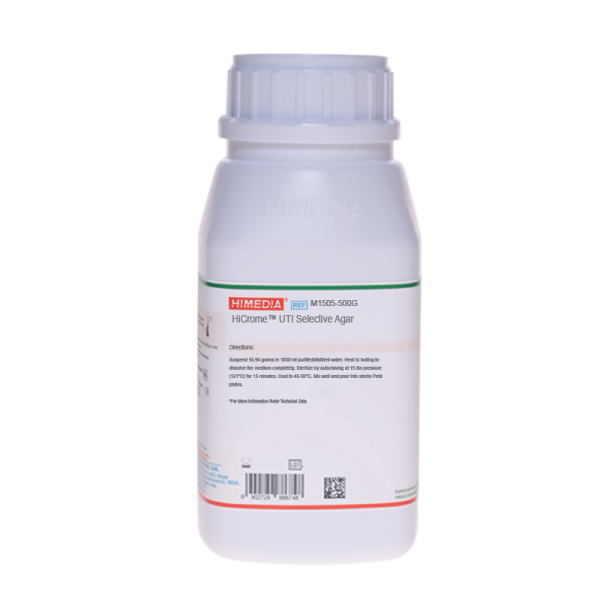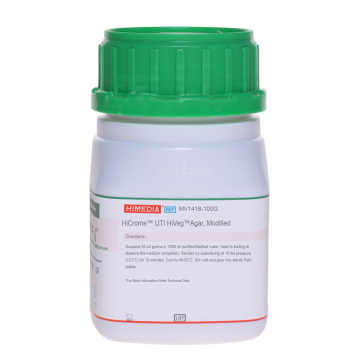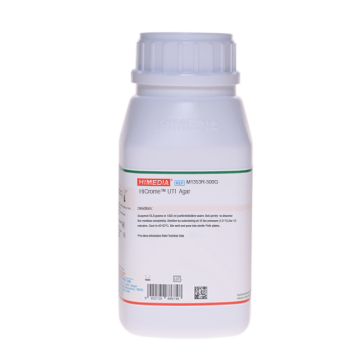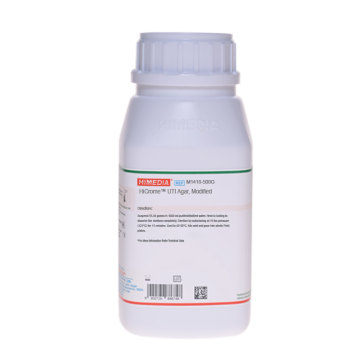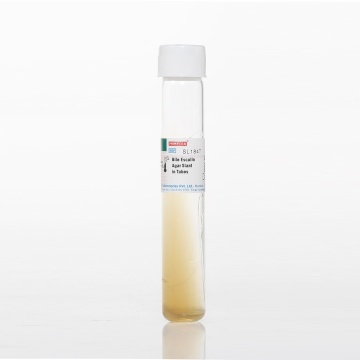 Your enquiry has been submitted
Your enquiry has been submitted
HiCrome™ UTI Selective Agar
Klebsiella#CC293D
Intended Use
Recommended for identification, differentiation and confirmation of enteric bacteria from specimens such as urine which may contain large number of Proteus species as well as potentially pathogenic Gram positive organisms.
Composition**
| Ingredients | g / L |
|---|---|
| Peptone | 18.000 |
| Tryptone | 4.000 |
| HM peptone B # | 6.000 |
| Bile salts | 1.500 |
| Chromogenic mixture | 12.440 |
| Agar | 15.000 |
Final pH ( at 25°C): 7.2±0.2
**Formula adjusted, standardized to suit performance parameters
Directions
Suspend 56.94 gram in 1000 ml purified/distilled water. Heat to boiling to dissolve the medium completely. Sterilize by autoclaving at 15 lbs pressure (121°C) for 15 minutes. Cool to 45-50°C. Mix well and pour into sterile Petri plates.
Principle And Interpretation
HiCrome™ UTI Selective Agar is formulated on the basis of work carried out by Pezzlo (1), Wilkie et al (2), Friedman et al (3), Murray et al (4), Soriano and Ponte (5) and Merlino et al (6). These media is a modification of HiCrome™ UTI Agar (M1353), which can be used in place of MacConkey Agar for isolation, and confirmation of various microorganisms. It facilitates and expedites the identification of some gram-negative bacteria and some gram-positive bacteria on the basis of different contrasted colony colours produced by reactions of genus or species specific enzymes with two chromogenic substrates.
Enzymes produced by Enterococcus species, Escherichia coli and coliforms cleave the chromogenic substrates incorporated in the medium. Presence of rich source of phenylalanine and tryptophan from peptone and tryptone provides an indication of tryptophan deaminase activity, revealed with TDA Reagent (R036) indicating the presence of Proteus species, Morganella species and Providencia species, which appear brown. One chromogenic substrate is cleaved by ß-glucosidase possessed by Enterococci resulting in formation of blue colonies. E.coli produce purple-magenta colonies due to the enzyme ß-D-galactosidase which cleaves the other chromogenic substrate. Further confirmation of E.coli can be done by performing indole test using DMACA Reagent (R035). Also some strains of Enterobacter cloacae lacking ß-glucosidase show pink-colonies indistinguishable from E.coli. The DMACA reagent for indole test (should be performed on filter paper) distinguishes between E.coli and Enterobacter, and also between Proteus mirabilis and other species. Coliforms produce purple coloured colonies due to cleavage of both the chromogenic substrates.
Peptone, HM peptone B and tryptone provides nitrogenous, carbonaceous compounds and other essential growth nutrients. HiCrome™ UTI Selective Agar is made selective by the addition of bile salts, which selectively inhibits gram-positive bacteria.
Type of specimen
Clinical samples : Urine, Faeces, etc.; Water samples.
Specimen Collection and Handling
For clinical samples follow appropriate techniques for handling specimens as per established guidelines (7,8). For water samples, follow appropriate techniques for sample collection, processing as per guidelines and local standards (9). After use, contaminated materials must be sterilized by autoclaving before discarding.
Warning and Precautions
In Vitro diagnostic use. For professional use only. Read the label before opening the container. Wear protective gloves/protective clothing/eye protection/face protection. Follow good microbiological lab practices while handling specimens and culture. Standard precautions as per established guidelines should be followed while handling clinical specimens. Safety guidelines may be referred in individual safety data sheets.
Limitations
- Since it is an enzyme-substrate based reaction, the intensity of colour may vary with isolates.
- Individual organisms differ in their growth requirement and may show variable growth patterns on the medium.
Performance and Evaluation
Performance of the medium is expected when used as per the direction on the label within the expiry period when stored at recommended temperature.
Quality Control
Appearance: Cream to yellow homogeneous free flowing powder
Gelling: Firm, comparable with 1.5% Agar gel
Colour and Clarity of prepared medium: Light amber coloured, clear to slightly opalescent gel forms in Petri plates
Reaction: Reaction of 5.69% w/v aqueous solution at 25°C. pH : 7.2±0.2
pH: 7.00-7.40
Cultural Response
Cultural characteristics observed after an incubation at 35 - 37°C for 18-24 hours.
| Organism | Inoculum (CFU) | Growth | Recovery | Colour of Colony | TDA (add 1-2 drops of TDA reagent) | DMACA (transfer colony on filter paper dipped in DMACA reagent) |
|---|---|---|---|---|---|---|
| Escherichia coli ATCC 25922 (00013*) | 50-100 | luxuriant | >=50% | purple-magenta | negative reaction | positive reaction, formation of blue purple colour around growth |
| Enterococcus faecalis ATCC 29212 (00087*) | 50-100 | fair | 20-30% | blue-blue green (small) | negative reaction | negative reaction |
| Klebsiella pneumoniae ATCC 13883 (00097*) | 50-100 | luxuriant | >=50% | blue to purple, mucoid | negative reaction | negative reaction |
| Proteus mirabilis ATCC 12453 | 50-100 | luxuriant | >=50% | light brown | positive reaction development of brown colouration | negative reaction |
| Pseudomonas aeruginosa ATCC 27853 (00025*) | 50-100 | luxuriant | >=50% | colourless (greenish pigment may be observed) | negative reaction | negative reaction |
| Staphylococcus aureus subsp. aureus ATCC 25923 (00034*) | >=104 | inhibited | 0% |
Key : *Corresponding WDCM numbers.
Storage and Shelf Life
Store between 15-25°C in a tightly closed container and the prepared medium at 2-8°C. Use before expiry date on the label. On opening, product should be properly stored dry, after tightly capping the bottle in order to prevent lump formation due to the hygroscopic nature of the product. Improper storage of the product may lead to lump formation. Store in dry ventilated area protected from extremes of temperature and sources of ignition. Seal the container tightly after use. Product performance is best if used within stated expiry period.
Disposal
User must ensure safe disposal by autoclaving and/or incineration of used or unusable preparations of this product. Follow established laboratory procedures in disposing of infectious materials and material that comes into contact with clinical sample must be decontaminated and disposed of in accordance with current laboratory techniques (7,8).
Reference
- Pezzlo M., 1998, Clin. Microbiol. Rev., 1:268-280.
- Wilkie M. E., Almond M. K. and Marsh F. P., 1992, British Medical Journal, 305:1137-1141.
- Friedman M. P. et al, 1991, J. Clin. Microbiol., 29:2385-2389.
- Murray P. R., Traynor P. and Hopson D., 1992, J. Clin. Microbiol.,30:1600-1601.
- Soriano F. and Ponte C., 1992, J. Clin. Microbiol., 30:3033-3034.
- Merlino et al, 1995, Abstr. Austr. Microbiol., 16(4):17-3.
- Isenberg, H.D. Clinical Microbiology Procedures Handbook 2nd Edition.
- Jorgensen, J.H., Pfaller, M.A., Carroll, K.C., Funke, G., Landry, M.L., Richter, S.S and Warnock., D.W. (2015) Manual of Clinical Microbiology, 11th Edition. Vol. 1.
- Lipps WC, Braun-Howland EB, Baxter TE,eds. Standard methods for the Examination of Water and Wastewater, 24th ed. Washington DC:APHA Press; 2023.
| Product Name | HiCrome™ UTI Selective Agar |
|---|---|
| SKU | M1505 |
| Product Type | HiCrome™ |
| Physical Form | Powder |
| Origin | Animal |
| Packaging type | HDPE |
| References | 1.Pezzlo M., 1998, Clin. Microbiol. Rev., 1:268-2802.Wilkie M. E., Almond M. K. and Marsh F. P., 1992, British Medical Journal, 305:1137-1141.3.Friedman M. P. et al, 1991, J. Clin. Microbiol., 29:2385-2389.4.Murray P. R., Traynor P. and Hopson D., 1992, J. Clin. Microbiol.,30:1600-1601.5.Soriano F. and Ponte C., 1992, J. Clin. Microbiol., 30:3033-3034.6.Merlino et al, 1995, Abstr. Austr. Microbiol., 16(4):17-3. |
| Customized Product Available | No |



